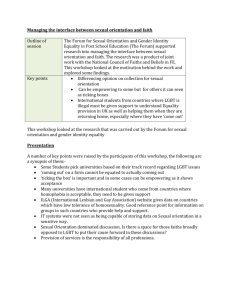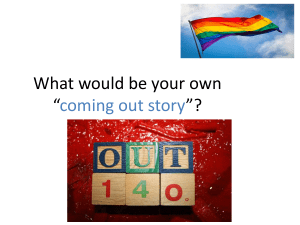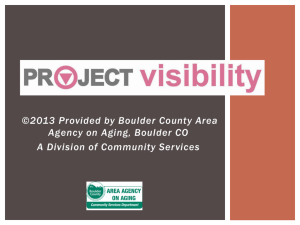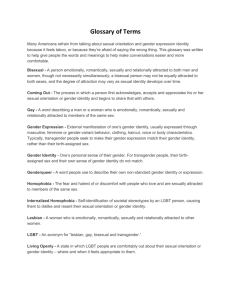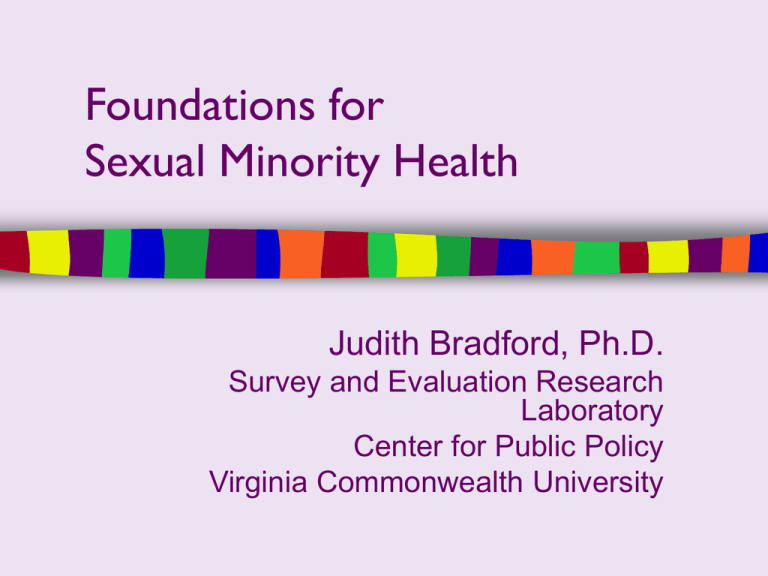
Foundations for
Sexual Minority Health
Judith Bradford, Ph.D.
Survey and Evaluation Research
Laboratory
Center for Public Policy
Virginia Commonwealth University
Learning Objectives
Describe the estimated number and distribution of sexual minorities
in the United States, how these estimates are derived, and how to
critically assess their utility.
Identify the most significant health concerns and barriers to
healthcare access of LGBT persons, within the context of health
disparities.
Use a social ecology model to discuss social, institutional, and policyrelated contexts influencing the quality of life that sexual minorities
can expect to achieve.
Describe the initiation and ongoing development of a public health
response to the healthcare needs of lesbian, gay, bisexual,
transgender (LGBT) and intersex persons.
Identify opportunities and challenges in sexual minority public health.
•
•
•
•
•
Population Characteristics
Health Concerns and Disparities
Social Ecological Model
Public Health Response
Opportunities and Challenges
Population Characteristics
Defining Sexual Orientation
• Definitional issues create significant problems for
representative sampling.
• Sexual orientation first gained widespread research
interest in the 1806s.
• Today, multiple dimensions are recognised.
• Researchers have growing interest to include
sexual orientation as a demographic variable in
studies.
• Operational definitions are critical.
Sell RL. 1997. Defining and measuring sexual orientation.
Archives of Sexual Behavior,Vol. 26, No. 6, 643-658.
Defining Sexual Orientation
• Conceptual definitions of sexual minority
populations are rarely included in research reports.
• Operational measures in published studies do not
always correspond with common
conceptualizations of sexual orientation.
• Researchers must clarify what they are studying
and recognize the effect of methods on findings.
Sell RL, Petrulio C. 1995. Sampling homosexuals, gays and
lesbians for public health research: A review of the literature
from 1990-1992. Journal of Homosexuality, 30:31-47.
Including Sexual Orientation
Measures in Health Research
• In a review of English-language articles published 1980-1999,
LGBT issues were addressed by 3777 articles, or 0.1% of all
Medline articles; 61% of the articles were disease-specific, and
85% omitted reference to race/ethnicity.
• Research unrelated to STD addressed lesbians and gay men
with similar frequency, bisexual persons were less frequently
considered, and the least amount of research focused on
transgender individuals.
• Findings supported that LGBT issues have been neglected by
public health research and that research unrelated to sexually
transmitted diseases is lacking.
Boehmer U. 2002.Twenty years of public health research: inclusion of
lesbian, gay, bisexual, and transgender populations.Am J Public Health.
92(7):1125-30.
What Is Not Captured Via the Census
No marriage like relationship
Single adult
Two related adults
Two Adults
Three or more adults
Two unrelated adults
Two men
Potential gay men and lesbians
unobservable from the data
Potential same-sex relationships that
are unobservable from the data
One man, one woman
Women
Census Data
Benefits and Limitations
• Benefits
• Short form data readily available and can be used to
look at geographic distributions
• Advanced query function
• Limitations
• Inferring sexual orientation; miss uncoupled gay men
and lesbians
• Controversy about recode procedures and
comparability of households from ’90 to ’00
• PUMS are samples of samples; complex data set
Comparing RDD and APD sampling for
sexual minority women’s surveys
Using best practices for data collection in both
methods, very similar response rates were
achieved. The percentages of lesbian and bisexual
women were nearly identical and quite high
(13%+), as were responses on health questions.
Results showed that HH sampling can be
successfully implemented with women of diverse
sexual orientations in the Boston area, a politically
and socially progressive urban area.
Comparison 1
HH
Our Total
Our Cost
Burden on
Cost
Per CM
Researcher
$51,163
$1,504.79 high
survey
Yield (N of lesbian HHs)
(gross yield):
34/767 = 4.6133%
(among enumerated HHs):
34/465 = 7.3118%
(among HHs known to be eligible):
34/342 = 9.9415%
RDD
$25,571
$913.26 medium
survey
(gross yield):
lesbian only 17/1250 = 1.36%
all 28/1250 = 2.24%
(among enumerated HHs):
lesbian only 17/681 = 2.4963%
all 28/681 = 4.1116%
(among HHs known to be eligible):
lesbian only 17/216 = 7.8704%
all 28/216 = 12.963%
PUMS
$7,466
$2.47 low
(with
$11,548
$3.81
equip.)
(gross yield): 3,028/5,140,746=.0589%
Utility
Comparison 2
Gross yield
HH
RDD
Among
Among
enumerated
known
HHs
eligible HHs
4.61
7.31
9.94
1.36/2.24
2.49/4.11
7.87/12.96
N
Cost
Total
Per case
34 lesbians
$51,163
$1,504.79
17 lesbians;
$25,571
$913.26
$11,548
$3.81
28 by Laumann
PUMS*
.0589
3,028 HHs
6,056 inds.
* includes equipment costs
Principal challenges for survey
researchers 1
• Usual issues:
• sampling frame issues
• geographic or other clustering
• targeting strategies
• representativeness
• generalizability
Principal challenges for survey
researchers 2
• Additional issues
• risky disclosure
• definitional issues
• characteristic not necessarily overt or
observable
• relative lack of resources to do research
• lack of criterion data
Health Concerns and
Disparities
Purpose of the White Paper
Provide a comprehensive review of:
1) methodologically sound GLBT
health studies
2) methods to better study the
health of GLBT people
Why? To inform policy: for example,
the Healthy People 2010 process
White Paper Contents
•
•
•
•
•
•
•
•
•
•
•
•
•
Public Health Infrastructure
Access to Quality Health Services
Health Education
Educational and Community-Based Programs
Cancer
Family Planning
HIV/AIDS
Immunization and Infectious Diseases
Mental Health and Mental Disorders
Sexually Transmitted Diseases
Tobacco Use
Violence and Sexual Assualt
Methodological Challenges to Research
www.glma.org
Priority Health Concerns
•
•
•
•
•
•
•
•
Mental Health
AIDS, HIV
STDs
Cancer
Tobacco
Substance Abuse
Provider lack of competence
Non-responsive health systems
Behavioral/Mental Health
•
•
•
•
Depression
Child rearing decisions
Nutrition, exercise
Unique features of counseling
Substance Abuse
•
•
•
•
AOD
Poppers
Methamphetamine
Tobacco
Social Ecological Model
Context for Poor Access and Health
Disparities
•
•
•
•
Stigma
Homophobia
Lack of family and community
Social disconnection
Result: vulnerable populations, subject to
all concerns that go with this.
Public Health Response
HP2010: Subgroups of Concern
for Eliminating Disparities
• Racial and ethnic minorities
• Populations defined by income, age,
and/or gender
• Populations with disabilities
• Populations defined by sexual orientation
• Populations defined by educational
attainment
• Populations defined by geographic locale
10 Leading Health Indicators
= LGBT disparities
•
•
•
•
•
•
•
•
•
•
Physical activity
Overweight and obesity
Tobacco use
Substance abuse
Responsible sexual behavior
Mental health
Injury and violence
Environmental quality (social)
Immunization
Access to health care
Probable Impact of Expanded Focus
on Sexual Orientation
• Opportunity for sexual minorities to receive increased
access and more culturally competent care
• Improve likelihood that sexual minorities will
experience increased quality and years of healthy life
• Facilitate the elimination of health disparities for LGBT
communities
• Creation of new approaches and dedicated resources
• Potentially substantive changes within the public health
infrastructure
Advocacy Meets the Scientific Method:
National Coalition for LGBT Health
• Conceived in late April 2000.
• First organizing meeting at the Millennium
March.
• Second organizing meeting in June 2000 at
Fenway, to develop coordinated plan with
GLMA and HRSA to write the companion
document.
• Formation meeting in DC October 2000.
Formation in 2000
January:
• HP2010 conference edition released
• white paper released
March: • HP2010 keynote at Scientific Workshop
• short paper released
April:
• meeting with Dr. Lurie in DC*
• discussion with Marty Rouse at Fenway
May:
• urban public health officials met in
Boston
• group discussion at Millennium March
June:
• Boston meeting to join HP2010
companion document and coalition
development
October:
• DC meeting to form the coalition
HP2010: The Companion
Document
• National workgroups broadly
representative of LGBT communities
• Focus on gender identity as well as
sexual orientation
• Leadership through GLMA, with HRSA
funding
• Presentation of draft document at
November APHA
Initial Concerns
HP2010 companion document
Inclusion of sexual orientation measures
in Federal surveys
Expanding coalition membership and
diversity
Communication within LGBT
communities and with government
agencies
Representation on federal committees
and advisor groups
Consensus-building for advocacy efforts
Critical steps in development of
LGBT research (selected)
• Institute of Medicine report on lesbian health
and research priorities (1999)
• March 2000 Scientific Workshop on Lesbian
Health
• Healthy People 2010
• white paper
• companion document
• National Coalition on LGBT Health
• Lesbian Health Conferences 2001-2004
• Annual LGBT Health Summits
State-Level Response:
Virginia Transgender Health Initiative
• Collaboration of VA Dept. of Health, Division of
HIV/STD, the Virginia HIV Community Planning
Group, and the Survey and Evaluation Research
Laboratory, HIV Working Group.
• Multi-phase study, qualitative and quantitative.
• Purpose: determine healthcare needs and barriers,
to support program development and capacity
building
• First phase – focus groups, now concluding
• Second phase – statewide survey in Fall 2004.
Opportunities and Challenges
The Fenway Institute
Fenway Community Health
…an interdisciplinary center dedicated to excellence
in gay, lesbian, bisexual and transgender (LGBT)
health, through active programs in research and
evaluation, training and education, and policy and
advocacy. The Institute was created in June 2002 as an
integral component of Fenway Community Health,
grounded in the reality of patient needs and the
practice of interdisciplinary, comprehensive health
and mental health care.
Howard Brown
Health Center
#
##
Outer Cape
Health Services
#
#
# # ##
#
#
#
#
#
#
### #
#
# # # ## #
##
##
## ## #
#
#
# #
##
###
### ### #
#
#
## # # # ##
#
#
#
#
#
#
# #
# # ##
# #
#
#
#
#
#
#
# ## # # # ##
# #
# # ## ###
## #
# #
## #
##
#
### # # #
#
#
#
#
#
#
#
## ##
# ## # ## # #
# ## ### #
#
#
# #### #
#
#
#
#
#
# # # #
#
### #
##
###
#
#
# ## ###
#####
# ##
#
#
#
#
#
#
#
#
#
#
#
#
#
#
#
##
# ##
#
###
# ## # # # #### #
#
#
##### #####
## ##
##### # ##### #
#
# #
#
#
## ### ##
#
#
#
#
#
#
#
#
#
#
#
#
#
#
#
#
#
##
#
### # # ## ## #####
## #
#
##
#
#
## # #
# ### ############# # # ##
##
# # ##
# ####
##
#
#
#
######
# # ######## # ######
# #
#### #
## #
######
###
###
### ######## #### # ## # # ## # #
##
#
#
###
##
## ###
###
###
#
#
##
###
##
##
#
#
#
##
# # ## #### ### ### #########
### ##
#
#####
##
## #
#
#
#
#
#
#
#
#
#
#
#
###
#
#
#
#
#
#
#
#
#
#
#
#
#
#
# # ## # ##
##
#
##
# # #### # ## ### #
## ####
# ##
# # #
# # ## # # ##
# # # #### ##
#
#
#
#
#
#
#
#
#
#
#
#
#
#
#
#
#
#
#
#
##
# ###
#
# #
#
## # # #
#
#
##
#########
#
#
##
#
#
#
#
#
# # # ## ### ## ## #
### ### ##
##
### ## # # #
## # #
# #
## ### ## ### # # # #### ## # # ### ######
# #
####
##
####
#
#
#
#
#
#
#
#
#
#
#
#
#
#
#
#
#
#
#
#
#
#
#
#
#
#
#
#
#
#
#
#
#
#
# # ## # # # ###
# ## # #
# # ## # # ######## # ### ## # # ### ## ##
######### # #### ## #
#
#
# # ## # # # #
#
# ## ###
# ## # # # ##
### ## #
# ## #
# ## ## #
##
###
# #####
## #####
### ####
#
# # ##
# #
## # # # #
# ## ###
# # #######
##### ### #
#
#
##
#########
###
###
###
##
#
## #
####
######### # ## #### # ## ###
### # ### ## ## # ### ###
##
#
##
### # ###
# ##
#
#
#
#
## #####
#####
### #
##
#
#
# # ### ##
##
#
#
#
#
#
#
#
#
#
#
#
#
#
#
# ##
## ## #
#
##
# #
# # # #
# #
#
# ### # ### #
## ##
#
#
# #
###
##### ##
#
# ##
## ###### ####
#
#
#
#
#
#
#
#
#
#
#
#
#
#
#
### # # ## ##
##
#
#
#
# # # ##### # ### #
##
### ####### # #
# # ## # ## # ## #
#
#
##
#
#
#
##
## ##
#
#
#
## # # # # ## #
## #### # ###### #
# # ##
# #
#
# ##
# ## #
#
#
#
#
# # #### # ## # ##
#
#
#
#
#
#
# ## # # # # # # ### # ### ######## # ## #
##
# #
#
#
#
#
#
#
#
#
#
#
##
# #
## ### # ##### # #
#
##
#
## ## #
# # # # ##
#
# # #
# ## #
## #
# ### ### #
## ##### ## # #
#
# ##
# ## # #
#
#
## # ###### ## #####
# ##
##### ##
# ###
# # ##
#### #
#
# #
#
## # ## #
## #### ## # #
## ##
## # # #
## # #
#
# #
## # #
# # ## #
# # # ## # # # ###### #
# # #### ########## # # ###
#
# #
# # # ##
# # # # # # ## ### ### ####
#
#
#
#
#
#
#
#
####
#
#
#
#
#
#
#
#
#
#
#
# ##
#
#
#
##
#
#
## # ##
### ## ####
#
#
#
#
#
#
#
#
#
#
#
#
#
#
#
#
#
#
#
#
#
#
#
#
#
#
#
#
# # #
# ## # ####
## ## # #### #
# ## #
#
#
#
# ##
#
##
#
## #
## ## ###### # #
### #### #
### # ######## # ###
#
#
#
# #
# # # ## # #
# ### ## #
#
#
# ## #
# # # # #
#
## ##
#
#
##
# ##
# # ##
#
# # #
##
##
# ## #####
#### #
#
##
#
##
###### ##
#### #
#
##
#### #
#
# ##
###
# ## #
# ##
#
#
#
#
#
#
#
#
#
#
# #
##
## ## # # # # # ## #
#
# # # # # ## ## ## ## #
#
#
## #
## #
##
###
# ## ## #
##
#
#
#
## #
# # #
####
##
##
# ####
# # #
# ##
## #
#
#
# # # ##
# # # ## # # ## # # #
#
#
## # ##
##
#
#
#
#
#
#
#
#
#
#
#
#
#
# # ### #### # ##
## #
# ### # # ## # ##
##
## # # # # ##
# ## #
#
#
#
# # ##
#
# # # # # ##
# ## #### # # ##
## ##
##
##
#
# #
# ## ############### #
#
# #
## # ##
#
#
#
#
# # # # ####
#
#
#
#
###
## ######## #
# # ##
#
####### #
# ## ## # #
# # ##
####### #
##
##
#
#
#
# #
##
#####
# ##
###
####
#
## ###
# # #### #
#
#
# # #######
## #
##### ##
#
# # ##
#
######
# #
###
######
##
#
#
#
##
#
#
Callen-Lorde
Community
Health Center
Chase Brexton
Health Center
#
LGBT Health Center
1 Dot = 250 Same Sex Households
2000 Census Data
LGBT Health Center
funded under Section
330 of the PHS Act
Created by Kirsten Barrett
Survey and Evaluation Research Laboratory
“Quitting with Friends”
Exploring the Potential of Close Social
Networks
• Fenway Community Health
• Howard Brown
• LA Gay and Lesbian Community Health
Center
Funded by the American Legacy Foundation, Priority
Populations Initiative
Why do so many of us smoke so much?
• We have a special kind of added stress from being
LGBT.
• We’ve learned to smoke where we socialize – the
cost of quitting is not simple.
• Maybe we are not as concerned for our own
health and well-being as others are.
• We set priorities, and short-term gains can seem
more important.
• Many of us, probably most of us, need help to
break the habit. And we also need to have our lives
as LGBT people!
What makes it harder for us to
quit for good?
• There’s something about smoking… it makes
certain things easier. So, we have to change,
learn to manage without the help of tobacco,
and this is hard to do.
• We have to believe that we can do it, that we
have what it takes to quit and stay that way.
• We must find, accept, and keep the support
and reinforcement that we need.
CSN – what’s different about it?
• Makes use of core curriculum that has been
found effective with “mainstream” groups and
tailored for LGBT groups – “Queer Tips” (UCSF).
• Adds the new component of doing cessation with
friends, people who know each other and who
decide as a “close social network” to engage in
change together.
• In 3 ways, further tailors the curriculum to make
explicit use of CSN group and interpersonal
dynamics.
Friends…
• Care for you when you need it and even
when you don’t
• Want the best for you
• Will help you if they can and if they know
how
• Try to do what they’ve promised
• Know where you live
and your LGBT friends…
In addition to all of the above, also…
• Share your struggles to live in a
homophobic and genderphobic world
• Have been there, too
• Know what makes you laugh, how to be
there when you cry, and where you like
to play
Intersex Health
Pilot Study Design
• Sponsored by the Intersex Society of North
America (ISNA) in 2001
• Sample = 50 pediatric endocrinology fellowship
programs in US and Canada
• Two phases: pilot study by email (16 returned);
revised survey by email and mail to nonresponders (24 returned).
• Response Rate = 29/50 (58%) – 90% from US;
10% from Canada. 5 pilot respondents included
for core questions.
Limitations
• Not all institutions include the same
syndromes in their definition of
intersex conditions.
• 5 respondents to the pilot survey did
not receive the full set of questions.
• Coding challenges for open-ended
questions.
Patients Seen
• Responding programs saw a combined approx.
total of 700 patients annually.
• 190 (27%) were infants.
• Age range of patients – birth to 50 years of
age.
• 1-30 infants seen annually (average = 7); 1100 all intersex patients seen annually
(average = 30).
• Age range = birth – 50.
Psychological Support
• 69% of the responding programs offered mental
health services to patients and families.
• 59% had certified mental health professionals on
staff.
• Types of support:
• child psychologists, psychiatrists, and social
workers
• web site resources, patient advocacy groups,
and support groups
• 7% of practices refer their patients elsewhere.
Physicians’ Comments
• “Not an integral part of group or our institution.”
• “Several involved – no one with particular
expertise.”
• “We work in a county hospital with limited
resources. It’s a depressing, deplorable state of
affairs.”
• “Response to “Does your group include one or
more certified mental health specialists?” ‘I
answer no with great regret.’
Psychological Support
• 69% of the responding programs offered
psychological support.
• 19% of their patients and/or families received
support during diagnosis.
• 15% received support after diagnosis.
• What accounts for such limited acceptance?
• Perhaps trust is an issue; support is usually given by
physicians on the treatment team, rather than by
trained mental health staff.
Physicians’ Comments
• “It’s offered to all but not generally chosen.
Strange, isn’t it?”
• “I think our psychological evaluation and
support here is not adequate for patient needs.
Only most obvious problem ones seem to get
support.Yet, probably the need is universal for
all patients with this sort of condition.”
• “Very rarely given. We physicians try to provide
as needed.”
Summary
• There appears to be:
• a dearth of mental health practitioners with intersex
experience
• which may stem from a lack of intersex training
programs for mental health professionals
• Available support is often not accepted by patients and
families.
• It is unclear who determines the need for these
services and on what basis.
• Patients who travel long distances for medical care may
be unwilling and/or unable to also travel for support
services, hoping to find them closer to home.
Needs
• Training on intersex conditions and family impact for
medical and mental health providers, in community as
well as institutional settings
• Increased multi-disciplinary provider teams
• Strategies for encouraging parents to accept help when
offered
• Development of accessible, community-based services
• Additional research to explore reasons why parents do
not accept needed help when offered
• Inclusion of effective mental health and social support
components within comprehensive intersex
management protocols.
Multicultural AIDS Coalition of
Boston
• Forging collaboration between minority-based
and research-based community HIV organizations
• Developing and evaluating culturally-based “Health
System Navigation” for HIV testing and medical
care engagement and retention
• African American Women, Faith Communities,
MSM, IDUs
Lessons Learned
• Institutional cultures vary significantly between the
agencies, which has a direct effect upon working
styles.
• This gap need not become a barrier to partnership,
especially when management of both agencies
consider the longer-term benefit of partnership
efforts and actively support its evolution.
• Substantial time must be invested at start-up to
create an effective partnership and to build the
infrastructure of agreements that can ensure its
sustainability.
Sexual Minority Women of Color:
A Summit for Building Community Research
Partnerships
5th Annual
Lesbian and Bisexual Women’s Health Research Forum
October 4, 2002
Beth Israel Deaconess Hospital
Boston, Massachusetts
Primary Objectives of the Forum
Review previous and current research relevant to sexual
minority women of color
Identify research initiatives which will assist with the
elimination of health disparities for lesbian and bisexual
women of color
Explore the benefits of research participation to
community based organizations
Identify and prioritize the health care needs of lesbian and
bisexual women of color in Boston
Identify the research interests of people who provide
services to sexual minority women of color in Boston
Identify barriers to conducting research that is sensitive to
the concerns of sexual minority women of color and to the special
outreach strategies necessary for study recruitment, and to
Develop workable solutions towards overcoming these
barriers
What are the barriers to doing community
research with sexual minority women of
color in Boston?
Isolation
Distrust
Racism and Sexism
Sexual Minority Identification
Organizational Constraints
Societal Constraints
Same-Sex Marriage: A Health
Issue?
Research Findings
• A decade of research on marital interaction suggests
that marital functioning is consequential for health, with
gender-related differences.
• Marriage’s protective effects are stronger for men than
for women.
• Marriage’s damaging effects are stronger for women
than for men.
• Interventions with couples have proven efficacious,
although not to the extent desired.
• Continued efforts to develop efficacious interventions
have the potential for sizable yields in physical and
mental health.
Kiecolt-Glaser JK, Newton, TL. 2001. Marriage and health: His and
hers. Psychological Bulletin, Vol. 127, No.4, 472-503.
Same-Sex Marriage and the Federal
Budget
• Congressional Budget Office report concludes that
allowing same-sex marriages would improve the
Federal budget’s bottomline by less than $1 billion
in each of the next 10 years. (assumes that samesex marriages are legalized in all 50 states and
recognized by the Federal government.
• Losses in some benefit areas would be offset by
gains in others.
• Some same-sex couples would gain, others would
lose.
Emerging Population
• The AIDS crisis opened a way to address broader
challenges of LGBT health
• Community mobilization
• Integration of research, program development,
and coalition building
• Increasing awareness of diversity among sexual
minorities
• Continuously organizing for change
Desired Response from Federal
Government
• Add sexual orientation measures to national
data systems (ensuring parity with other
populations noted for disparities)
• Develop funding opportunities to support
researchers in addressing these issues
• Spell out detailed expectations for researchers.
• Complete the promise of HP2010.
From Academic Institutions
• Train and mentor the next generation of
researchers.
• Develop studies to address the most critical
questions.
• Do these things in partnership with LGBT
community groups, health care providers, and
sponsoring organizations.
Shared Responsibility
• Attain consensus on research priorities
and pursue funding.
• Address methodological challenges with
creative approaches.
• Use results to develop interventions for
health promotion and quality of life.
• Disseminate results to LGBT communities,
health care providers, and researchers
studying sexual minority health.
National Leadership
•
•
•
•
•
•
•
Gay and Lesbian Medical Association
National Lesbian and Gay Task Force
Human Rights Campaign
Mautner Project for Lesbians with Cancer
National Coalition for LGBT Health
GLAD
Gill Foundation


